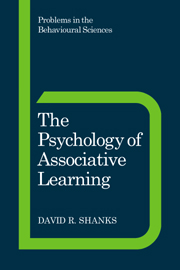4 - Connectionism and learning
Published online by Cambridge University Press: 26 January 2010
Summary
In the Introduction I argued that human associative learning can best be understood by considering three questions. What does the system do? How, in broad informational terms, does it do it? And how is this achieved at the mechanistic level? We have answered the first question by suggesting that to a first approximation the system does what a statistician would do: that is to say, it computes the degree of conditional contingency between events as defined by the metric ΔP. The second question is answered (again to a first approximation) by reference to the memorisation of instances, with stimuli being represented in a multidimensional psychological space and with interstimulus similarities being an exponential function of distance in the space. We now turn to our final question: what is the mechanism of learning? What sort of mechanism computes contingency, and represents associative knowledge in terms of memorised instances? In this chapter we will examine how contemporary associationist learning systems attempt to answer this final question.
I also pointed out in the Introduction that enthusiasm for associationist accounts of human learning waned somewhat in the 1960s and 1970s. Partly, this was due to impatience with the highly constrained tasks that researchers in the verbal learning tradition employed, but partly it was also due to the apparent inability of associationist theories to cope with more complex examples of human learning and cognition. For instance, a number of extremely sophisticated analyses had been undertaken of the difference between novices and experts performing various skills such as playing chess or remembering strings of digits (e.g. Chase and Ericsson, 1981; Chase and Simon, 1973).
- Type
- Chapter
- Information
- The Psychology of Associative Learning , pp. 104 - 151Publisher: Cambridge University PressPrint publication year: 1995



